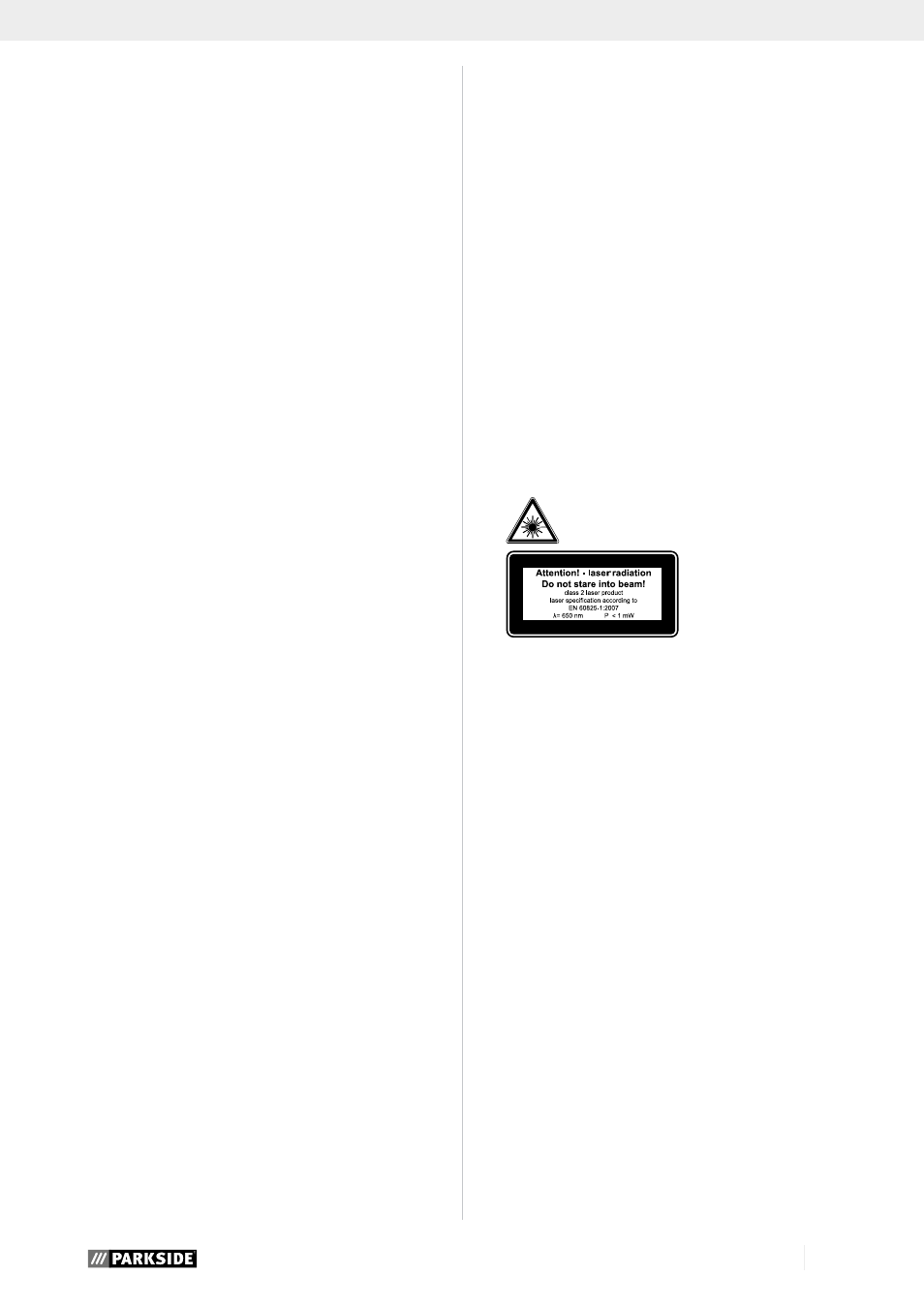Parkside PTK 2000 A1 User Manual
Page 54

49
GB
–
Report faults on the electric tool, protective
devices or the tool attachment to the person
responsible for safety as soon as they are dis-
covered.
3
Safe work
–
Use the push stick or handle with sliding wood,
to pass the workpiece securely out off the saw
blade.
–
Make sure that the riving knife is always used,
and set up is correctly.
–
Use the upper blade guard and set it to the cor-
rect position.
–
Only use saw blades for which the maximum
permissible speed is not lower than the maxi-
mum spindle speed of table saws and which are
suitable for the material to be cut.
–
Do not cut rebates or grooves without fitting a
suitable guard, e.g. a tunnel-type guard, over the
saw table.
–
Circular saws must not be used for slotting jobs
(cutting grooves which end in the workpiece).
–
When transporting the electric tool, only use
the transport devices. Never use the protective
devices for handling or transport.
–
Make sure that the upper part of the saw blade
is covered during transport, e.g. by the protective
device.
–
Be sure to only use spacers and spindle rings
specified by the manufacturer as suitable for the
intended purpose.
–
The floor around the machine must be level,
clean and free of loose particles, such as chips
and cutting residues.
–
Always stand to the side of the saw blade when
working with the saw.
–
Do not remove any cutting residues or other
parts of workpieces from the cutting zone while
the machine is running and the saw unit is not
at rest.
–
Make sure that the machine is always secured
on a workbench or a table if at all possible.
–
Support long workpieces (e.g. with a roller table)
to prevent them sagging at the end of a cut.
–
m
Attention! Never remove loose splinters, chips
or jammed pieces of wood while the saw blade is
running.
• Switch off the machine to troubleshoot or remo-
ve jammed pieces of wood. -
Disconnect the
main power plug -
• Refitting, including adjusting and measuring
works, and cleaning must be carried out only
when the motor is switched off. -
Disconnect
the main power plug -
• Before switching on again, ensure that keys
and adjustment tools have been removed.
Warning! This electric tool generates an electromag-
netic field during operation. This field can impair active
or passive medical implants under certain conditions. In
order to prevent the risk of serious or deadly injuries, we
recommend that persons with medical implants consult
with their physician and the manufacturer of the medical
implant prior to operating the electric tool.
SAFETY INSTRUCTIONS FOR THE HANDLING OF
SAW BLADES
1
Only use insertion tools if you have mastered their
use.
2
Observe the maximum speed. The maximum
speed specified on the insertion tool may not be
exceeded. If specified, observe the speed range.
3
Observe the motor / saw blade direction of rota-
tion.
4
Do not use any insertion tools with cracks. Sort out
cracked insertion tools. Repairs are not permitted.
5
Clean grease, oil and water off of the clamping
surfaces.
6
Do not use any loose reducing rings or bushes for
the reducing of holes on saw blades.
7
Make sure that fixed reducer rings for securing the
insertion tool have the same diameter and have at
least 1/3 of the cutting diameter.
8
Make sure that fixed reducer rings are parallel to
each other.
9
Handle insertion tool with caution. They are ideally
stored in the originally package or special contain-
ers. Wear protective gloves in order to improve
grip and to further reduce the risk of injury.
10
Prior to the use of insertion tools, make sure that
all protective devices are properly fastened.
11
Prior to use, make sure that the insertion tool
meets the technical requirements of this electric
tool and is properly fastened.
12
Only use the supplied saw blade for sawing opera-
tions in wood, materials similar to wood, plastics
and non-ferrous metals (except for magnesium and
alloys containing magnesium).
Attention: Laser radiation
Do not stare into the beam
Class 2 laser
Protect yourself and you environment from acci-
dents using suitable precautionary measures!
•
Do not look directly into the laser beam with unpro-
tected eyes.
•
Never look into the path of the beam.
•
Never point the laser beam towards reflecting sur-
faces and persons or animals. Even a laser beam
with a low output can cause damage to the eyes.
•
Caution - methods other than those specified here
can result in dangerous radiation exposure.
•
Never open the laser module. Unexpected exposure
to the beam can occur.
•
If the saw is not used for an extended period of time,
the batteries should be removed.
•
The laser may not be replaced with a different type
of laser.
•
Repairs of the laser may only be carried out by the
laser manufacturer or an authorised representative.
Safety instructions for handling batteries
1
Always make sure that the batteries are inserted
with the correct polarity (+ and –), as indicated on
the battery.
2
Do not short-circuit batteries.
3
Do not charge non-rechargeable batteries.
4
Do not overcharge batteries!
5
Do not mix old and new batteries or batteries of
different types or manufacturers! Replace an entire
set of batteries at the same time.
6
Immediately remove used batteries from the device
and dispose of them properly!
7
Do not allow batteries to heat up!
8
Do not weld or solder directly on batteries!
9
Do not dismantle batteries!
10
Do not allow batteries to deform!
11
Do not throw batteries into fire!
0
